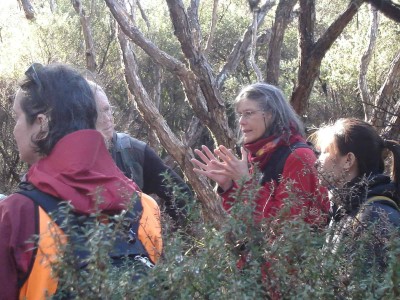Luitgard Schwendenmann, training the next generation
Luitgard is an ecosystem scientist by training. She completed a PhD at Georg August University Goettingen, Germany, and specialises in the cycling of carbon, nutrients and water in the soil-plant-atmosphere continuum.
In 2010, Luitgard came to New Zealand for a position in the School of Environment, Faculty of Science, at the University of Auckland. We’re pleased to congratulate Luitgard on climbing the ranks and being promoted to professor earlier this month!
Luitgard (left) in the field with student Hoa Nguyen.
But back when she first started, and as is the case with many junior faculty, Luitgard hadn’t yet obtained any large research grants to support her research and her students.
“I started doing research in urban ecosystems because of the proximity and accessibility for students,” says Luitgard.
Her work in these forests naturally put her in touch with the growing research effort dedicated to kauri.
“I got introduced to the issue of kauri dieback by Nick Waipara in 2011,” says Luitgard. “I started looking into the implications of pathogens on ecosystem functions and processes.”
Then in 2013, Luitgard organised a symposium on the future of forests in Australasia focusing on the impact of Phytophthora species on plant composition and ecosystem functioning at EcoTas. There, she met Mahajabeen Padamsee, now the programme leader for Beyond Myrtle Rust.
“Maj was working on arbuscular mycorrhizal fungi associated with kauri roots,” says Luitgard. “So we stayed in touch and over time co-supervised some students and summer students.”
When funding was made available through Beyond Myrtle Rust and Ngā Rākau Taketake to conduct research in myrtle rust, Luitgard jumped at the opportunity to engage students in researching this disease.

“I was able to offer scholarships, which created a bit of momentum,” says Luitgard. “And students talk to other students, so some students opted to bring their own funding through University of Auckland scholarships to work on myrtle rust.”
Luitgard is passionate about supervising students in a way that gives them access to what research is really about.
“Sometimes students are seen as a risk because you never know how a project may turn out,” says Luitgard. “I am always happy to take on that risk because I really think it’s important to train the next generation and give students the opportunity to get engaged with and exposed to the broader community through annual general meetings, attending conferences, and engaging with mana whenua. That hopefully creates a lot of opportunities beyond learning new techniques and skills.”
Because of investments made by Luitgard and many others into nurturing an interest in our myrtles in upcoming scientists, students are some of the researchers who will be carrying the myrtle rust research banner beyond the end of the Beyond Myrtle Rust and Ngā Rākau Taketake programmes. Students are one of the reasons Luitgard is confident that myrtle rust research has a bright future in New Zealand.
Jenny Leonard
